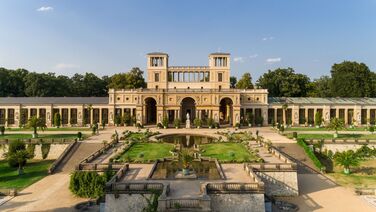Church of PeacePiety and Political Reaction
In 1845, exactly 100 years after the foundation stone was laid for Sanssouci, King Frederick William IV instructed that a court church be built at the foot of the vineyard terraces. There had been no court church in the mundane, “carefree” world of the free spirit Frederick II. This new house of worship was to provide a religious base for the heirs to the dynasty. At the time the church was consecrated in 1848, the revolution in Berlin had shaken the monarchy’s claim to absolute rule “by the grace of God”. But nevertheless, the King persevered with his plan to dedicate his new court church to the eternal “Prince of Peace”, since worldly princes received their reigns only from Him. The consecration of the Church of Peace was meant as an overt challenge to the followers of the revolution that was soon to be quelled by a force of arms.
The construction designs of the church were oriented to the oldest church buildings in Italy (San Clemente in Rome). With this, purportedly original Christian forms were to be regained, as was, to the King’s way of thinking, the original spirit of Christianity, with which he hoped to renew the church and society. Based on sketches made by Frederick William IV himself, Ludwig Persius and August Stüler worked out the design and the building plans.
Unlike the unpretentious exterior of the church, the interior decoration is characterized by colored marble. Adorning the apse is an original mosaic (first half of the 13th century) from San Cipriano Church in Murano near Venice. Beneath the church nave are the tombs of Frederick William IV and his consort Elisabeth.
In keeping with the style of sacred medieval buildings, attached to the church are a cloister, a courtyard with colonnades and a covered portico. Among the numerous works of art is the statue of Christ Blessing, a copy after a work by Bertel Thorvaldsen.
Adjacent to the buildings are, to the east, an artificial lake, and to the west, the Marly Garden. Earlier on, this had been the kitchen garden of Frederick William I, but it was converted into a miniature landscape garden by Peter Joseph Lenné. The plants there and a white-and-blue glass column are reminiscent of the Bavarian homeland of the Queen.
Friedenskirche
Am Grünen Gitter 3
14469 Potsdam
Public Transportation
Stop "Potsdam, Luisenplatz-Nord/Park Sanssouci"
vbb-online | Timetable information
Traffic information
Parking
Paid parking spaces for cars and buses in the car park P1 – At the Historic Windmill.
Closed during events
Admission for donation
14469 Potsdam
friedenskirche@evkirchepotsdam.de
Phone: 0331.97 40 09
Visitor Centre Historic Windmill in Sanssouci Park
An der Orangerie 1
14469 Potsdam
Closed Mondays
Visitor Centre New Palace in Sanssouci Park
Am Neuen Palais 3
14469 Potsdam
Closed Tuedays
info@spsg.de
Phone: +49 (0)331.96 94-200 (Tue-Sun)




















